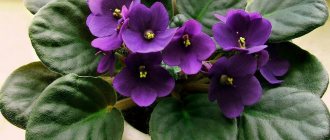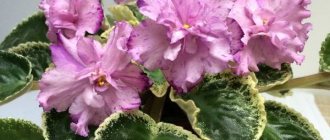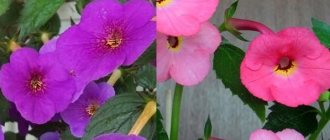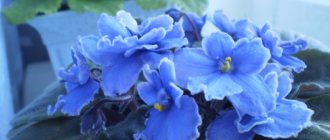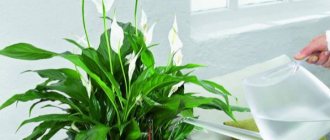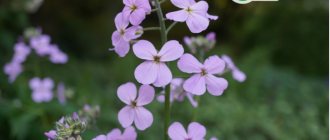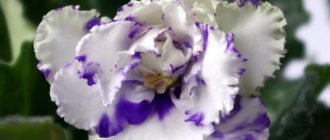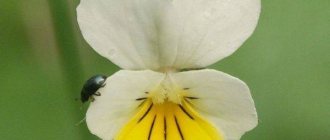If you compare from photos the varieties of violets offered to gardeners today and the plants once discovered in the wild, it is difficult to imagine that, in fact, these are closest relatives. Varietal Saintpaulias have become so bright and original that they have never ceased to delight lovers of indoor plants for many years. Look at the tulip tree photo!
Features of flowering, growth and reproduction
Development at home
Under good conditions, violets will delight you with good flowering.
Arapaha is an unpretentious violet; with proper care, it develops quickly and blooms almost without stopping. With timely transplantation and rejuvenation, the plant can live in the house for a long time.
How long does it take to grow an adult plant?
Violet babies grow up very quickly, much faster than other varieties. Under favorable conditions, the plant will bloom in less than 6 months after planting; under unfavorable conditions, flowering can wait up to a year.
How are varietal characteristics transmitted?
Varietal violet Arapaha is propagated by two methods :
- Stepchildren;
- Or leaf cuttings.
The stepsons growing in the axils of the leaves completely repeat all the varietal characteristics of the plant .
Children obtained from the leaf often give sports .
Nuances of flowering
The first flowering is almost always not abundant - 2-3 peduncles.
During subsequent flowering, the violet is simply strewn with flowers , which gradually change color saturation, turning from red to dark burgundy.
If you do not create the appropriate conditions for keeping the violet, then white inclusions may appear in the red color of the flowers.
What do flower stalks look like?
Saintpaulia has quite strong peduncles.
Peduncle variety:
- Sturdy;
- Quite long.
Arapah's flowers are quite large, reaching 6 cm in diameter .
Is it possible to achieve cap flowering?
To form cap blooms in violets, you need an ideal rosette , not too dense to allow the emerging flower stalks to pass through. Arapaha is ideal for conditions of cap flowering; it forms the necessary correct rosette. Its elongated leaves freely allow flower stalks to pass through.
If the correct maintenance conditions , usually from the second flowering Arapaha independently, without any outside measures, begins to bloom with a cap.
If in the second flowering of the plant it was not possible to achieve cap flowering, then the conditions of maintenance need to be reconsidered .
IMPORTANT! If 2-3 peduncles appear on a flower, they need to be removed for the further development of more peduncles.
Bud lifespan
The Arapaha rosette is even, blooms often and profusely . Violet can bloom continuously for up to a year.
Violet Arapah (K.Stork)
Fantastic violet Arapah.
The Arapaha violet variety belongs to the Gesnerieceae family , genus Saintpaulia. Arapaha belongs to the so-called “red” varieties.
by American breeder Kent Stork in 1992 .
Kent Stork is a famous Saintpaulia breeder from the USA , who has bred and registered more than 160 new varieties.
ATTENTION! Stork really liked “Indian” names and named the variety he developed in honor of the Arapaho Indian tribe.
Photo and description of the Arapaha variety
Saintpaulia has bright burgundy flowers.
Arapaha red-burgundy flowers Violet corollas are star-shaped. Leaves:
- Light green;
- Flat;
- Elongated shape.
Stork considered brittle leaves a disadvantage of the variety . The petioles of the leaves are really too long. On the other hand, it rather adds charm, distinguishing the variety from others and giving it an appearance that is recognizable even in the absence of flowers.
Sportability of the variety
Children obtained from Arapaha leaf cuttings can produce sports - this is the difference between violets and the varietal description.
Arapaha sports are not at all resilient and may revert to varietal color.
Arapaha Sports has :
- Red-burgundy flowers with chaotic bright white spots;
- White flowers with burgundy spots or core.
ADVICE! The fixation of sports is carried out by propagating it from leaf cuttings or stepson.
Reviews
speak very . Here are some reviews from violet lovers.
Olesya. “It has a rich blood-red hue, is not capricious, has an even rosette, and blooms frequently and abundantly.”
Bright burgundy flowers attract the attention of many gardeners.
Antonina. “A good variety - it loves to bloom, the flowers are large, bright, the leaves lie evenly, it reproduces without problems.”
Valentine. “The color of the flowers is simply extraordinary, the flowers last a very long time, the color does not fade or fade, but rather becomes denser over time. Peduncles are very strong. The rosette forms itself, smooth, compact.”
Optimara violet: variety description and characteristics
Violet Optimara: photo of the variety
In most cases, you can find violets whose names do not at all match their original name. For example, violets that are grown on windowsills are called Saintpaulia. This flower is attractive, its color is unusual, it is part of the Gesneriev genus. The well-known version of violet is Uzambara, it can be purchased at any gardening store, as well as in supermarkets; it is ideal for home use, even for beginners.
The Optimara violet has been known since one thousand eight hundred and ninety-two; its home is the eastern territory of Africa, growing in coastal places, next to waters in moist soil. Its discoverer was Baron Walter von San-Paul, he collected the seeds and brought them to Germany. Thus, the violet was named sanpolia in honor of this baron. Since one thousand eight hundred and ninety-three, the plant fully participated in fairs and exhibitions in Germany, then it became known throughout the world.
The variety of this flower is off the charts, there are more than thirty-two thousand varieties, a couple of them belong to domestic gardening. The plant is constantly green in color and lives for a large number of years. In appearance it has a small stem, the leaves grow from the roots. The color of the leaves can be dense green, and they can also be spotted. The leaves seem to be terry, even, rounded, in the shape of a heart. The buds consist of five petals connected to each other. The box contains two stamens, one pistil, an ovary at the top, and two carpels.
The seeds of the Optimara violet variety sit in a box; in appearance they are small oval seeds, elongated on one side. The plant can be propagated using leaves cut from the parent bush, then they are left to settle in water, then planted in the soil. It is recommended to use special soil; it can be purchased at a gardening store, or you can make it yourself, adding pine needles, turf, leaves, and peat to its composition.
For the rapid development of the plant, it needs to be weeded, hilled, and you also need to add: perlite, vermiculite, sand from the coast of reservoirs, sphagnum. You should also regularly moisten the soil and ensure that there is no drought. Also make sure that there is no stagnation of water in the soil, otherwise the plant will begin to rot and eventually die.
For the comfort of the Optimara violet, you should regulate: temperature, air humidity, lighting. If all these points are fulfilled, then the plant will respond in kind, show all its beauty, and will delight the grower for a sufficient time.
